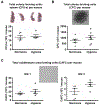Long-term adaptation to hypoxia preserves hematopoietic stem cell function
- PMID: 27118043
- PMCID: PMC6506184
- DOI: 10.1016/j.exphem.2016.04.010
Long-term adaptation to hypoxia preserves hematopoietic stem cell function
Abstract
Molecular oxygen sustains aerobic life, but it also serves as the substrate for oxidative stress, which has been associated with the pathogenesis of disease and with aging. Compared with mice housed in normoxia (21% O2), reducing ambient oxygen to 10% O2 (hypoxia) resulted in increased hematopoietic stem cell (HSC) function as measured by bone marrow (BM) cell engraftment onto lethally irradiated recipients. The number of BM c-Kit(+)Sca-1(+)Lin(-) (KSL) cells as well as the number of cells with other hematopoietic stem and progenitor cell markers were increased in hypoxia mice, whereas the BM cells' colony-forming capacity remained unchanged. KSL cells from hypoxia mice showed a decreased level of oxidative stress and increased expression of transcription factor Gata1 and cytokine receptor c-Mpl, consistent with the observations of increased erythropoiesis and enhanced HSC engraftment. These observations demonstrate the benefit of a hypoxic HSC niche and suggest that hypoxic conditions can be further optimized to preserve stem cell integrity in vivo.
Published by Elsevier Inc.
Figures




Similar articles
-
Hematopoietic-repopulating defects from STAT5-deficient bone marrow are not fully accounted for by loss of thrombopoietin responsiveness.Blood. 2004 Apr 15;103(8):2965-72. doi: 10.1182/blood-2003-08-2963. Epub 2003 Dec 30. Blood. 2004. PMID: 15070672
-
Fms-related tyrosine kinase 3 expression discriminates hematopoietic stem cells subpopulations with differing engraftment-potential: identifying the most potent combination.Transplantation. 2008 Apr 27;85(8):1175-84. doi: 10.1097/TP.0b013e31816a89cf. Transplantation. 2008. PMID: 18431239
-
Differential expression of alpha2 integrin separates long-term and short-term reconstituting Lin-/loThy1.1(lo)c-kit+ Sca-1+ hematopoietic stem cells.Stem Cells. 2006 Apr;24(4):1087-94. doi: 10.1634/stemcells.2005-0396. Epub 2005 Dec 22. Stem Cells. 2006. PMID: 16373693
-
Quantitative assessment of the stem cell self-renewal capacity.Ann N Y Acad Sci. 2001 Jun;938:18-24; discussion 24-5. doi: 10.1111/j.1749-6632.2001.tb03570.x. Ann N Y Acad Sci. 2001. PMID: 11458506 Review.
-
Extravascular coagulation in hematopoietic stem and progenitor cell regulation.Blood. 2018 Jul 12;132(2):123-131. doi: 10.1182/blood-2017-12-768986. Epub 2018 Jun 4. Blood. 2018. PMID: 29866813 Free PMC article. Review.
Cited by
-
Pre-Conditioning Methods and Novel Approaches with Mesenchymal Stem Cells Therapy in Cardiovascular Disease.Cells. 2022 May 12;11(10):1620. doi: 10.3390/cells11101620. Cells. 2022. PMID: 35626657 Free PMC article. Review.
-
Mutant p53-dependent mitochondrial metabolic alterations in a mesenchymal stem cell-based model of progressive malignancy.Cell Death Differ. 2019 Sep;26(9):1566-1581. doi: 10.1038/s41418-018-0227-z. Epub 2018 Nov 9. Cell Death Differ. 2019. PMID: 30413783 Free PMC article.
-
Hypercholesterolemia Tunes Hematopoietic Stem/Progenitor Cells for Inflammation and Atherosclerosis.Int J Mol Sci. 2016 Jul 19;17(7):1162. doi: 10.3390/ijms17071162. Int J Mol Sci. 2016. PMID: 27447612 Free PMC article. Review.
-
The Vascular Niche for Adult Cardiac Progenitor Cells.Antioxidants (Basel). 2022 Apr 29;11(5):882. doi: 10.3390/antiox11050882. Antioxidants (Basel). 2022. PMID: 35624750 Free PMC article. Review.
-
From causes of aging to death from COVID-19.Aging (Albany NY). 2020 Jun 12;12(11):10004-10021. doi: 10.18632/aging.103493. Epub 2020 Jun 12. Aging (Albany NY). 2020. PMID: 32534452 Free PMC article. Review.
References
-
- West JB. Highest permanent human habitation. High Alt Med Biol. 2002; 3:401–407. - PubMed
-
- Mortimer EA Jr., Monson RR, MacMahon B. Reduction in mortality from coronary heart disease in men residing at high altitude. N Engl J Med. 1977; 296:581–585. - PubMed
-
- Weinberg CR, Brown KG, Hoel DG. Altitude, radiation, and mortality from cancer and heart disease. Radiat Res. 1987; 112:381–390. - PubMed
-
- Faeh D, Gutzwiller F, Bopp M. Lower mortality from coronary heart disease and stroke at higher altitudes in Switzerland. Circulation. 2009; 120:495–501. - PubMed
-
- Winkelmayer WC, Liu J, Brookhart MA. Altitude and all-cause mortality in incident dialysis patients. JAMA. 2009; 301:508–512. - PubMed
Publication types
MeSH terms
Grants and funding
LinkOut - more resources
Full Text Sources
Other Literature Sources
Medical
Research Materials

